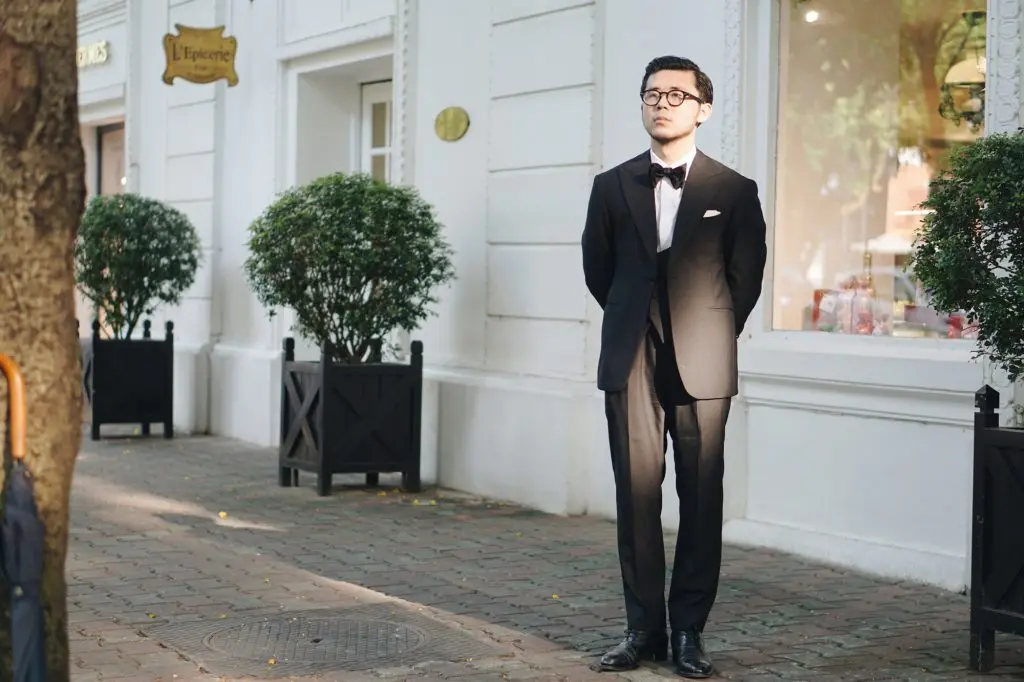Few outfits speak the language of elegance and sophistication quite like a tuxedo. It’s not just clothing, it’s a statement. When an invitation reads black tie, it’s more than a dress code; it’s a call to show up looking your absolute best.
But wearing a tuxedo isn’t as simple as throwing on a jacket and tie. It’s a curated ensemble with specific rules and traditions, from the type of shirt to the cut of the trousers, and even the knot of the bow tie. Unfortunately, many fall short by missing the finer details, resulting in a look that feels incomplete or incorrectly styled.
In this comprehensive tuxedo guide, we’ll walk you through everything you need to know: how to wear a tuxedo with confidence, how to style it for modern flair without straying from tradition, and how to avoid the common mistakes that can undo your entire look. This black tie guide will equip you with both the knowledge and the subtle elegance needed to wear a tux the right way and wear it well.
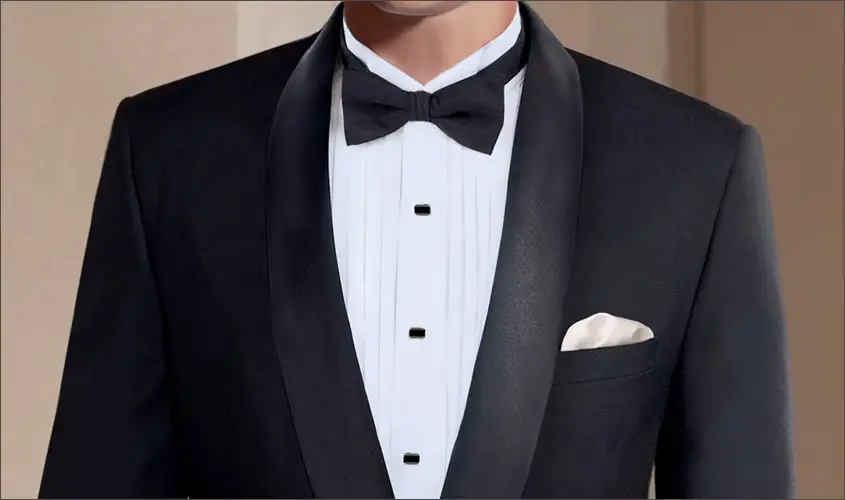
What Makes a Tuxedo a Tuxedo?
Before diving into how to wear a tuxedo, it’s important to understand what sets it apart from a regular suit. While the two may look similar at a glance, there are key details that define a tuxedo and give it its formal edge, making it the preferred choice for black tie occasions.
1. Satin Accents
One of the most distinguishing features of a tuxedo is the use of satin. You’ll typically find satin on the lapels, buttons, and the stripe that runs down the side of the trousers. This subtle sheen adds a layer of formality that ordinary suits simply don’t have.
2. No Belt Loops
Tuxedo trousers are designed without belt loops. Instead, they’re held up by side adjusters or suspenders (braces). This contributes to the clean, uninterrupted look that defines formalwear.
3. Minimalistic Design
A tuxedo is meant to be elegant in its simplicity. While suits may come in a wide range of colors, patterns, and textures, tuxedos stick to solid, darker tones , most often black, midnight blue, or white jackets for very formal occasions.
4. Specialized Shirts and Accessories
Tuxedos are worn with specific shirts , typically with pleated or pique fronts and designed to accommodate studs rather than standard buttons. Accessories like bow ties, cufflinks, cummerbunds, and polished dress shoes are also standard parts of the tuxedo ensemble.
5. Reserved for Formal Settings
While suits are suitable for business or semi-formal events, tuxedos are strictly reserved for formal or evening occasions. This is where the concept of the black tie tuxedo comes into play, an outfit that adheres to tradition while allowing just enough room for personal style.
Understanding these core elements is the first step in mastering how to wear tuxedo attire correctly. The details may be subtle, but they make all the difference between simply dressing up and truly embodying black tie elegance.
When to Wear a Tuxedo
Tuxedos are not everyday attire, and that’s exactly what makes them special. They’re reserved for moments that demand distinction, sophistication, and ceremony. Understanding when wearing a tuxedo is appropriate helps you honor the event, the host, and the tradition of black tie style.
1. Black Tie Events
The most obvious occasion to wear a tuxedo is when the dress code says Black Tie. This is a formal standard that calls for a black tuxedo jacket and trousers, a formal dress shirt, a black bow tie, and appropriate accessories. Events like:
- Gala dinners
- Award ceremonies
- Opera nights
- Formal balls or fundraisers
fall under this category. A traditional black tie tuxedo is the expected attire here, not a dark suit, not a colored blazer.
2. Weddings
If the wedding invitation specifies black tie, a tuxedo is expected, even if you’re just a guest. Grooms and groomsmen often wear tuxedos to elevate the formality of the day. Evening weddings are especially ideal for tuxedo wear.
3. Proms and Formal Dances
Tuxedos are a popular choice for proms, especially in schools that observe formal traditions. While some students experiment with colors or unique accessories, the foundational rules of how to wear a tux still apply.
4. Creative Black Tie or Black Tie Optional
In some modern settings, the dress code might say Creative Black Tie or Black Tie Optional. This gives room for subtle personal expression, like swapping the classic black tuxedo jacket for a deep velvet one or adding tasteful accessories.
However, even in these settings, the base elements of tuxedo style remain important. If you’re wondering, can you wear a tie with a tux? In a traditional black tie setting, it’s best to stick with a bow tie. But for creative black tie events, a well-styled formal necktie may be acceptable if worn with confidence and care.
5. Formal Holiday Parties or High-Society Dinners
Occasionally, upscale holiday parties or private dinners hosted by elite circles may require a tuxedo. These are rare, but when the invite says black tie, it’s a signal to bring your formal best.
Wearing a tuxedo sends a message: that you respect the moment and the effort others have made to dress the part. Understanding the dress code and the formality of the event is essential to knowing how to wear a tux well, and when it’s truly appropriate to do so.
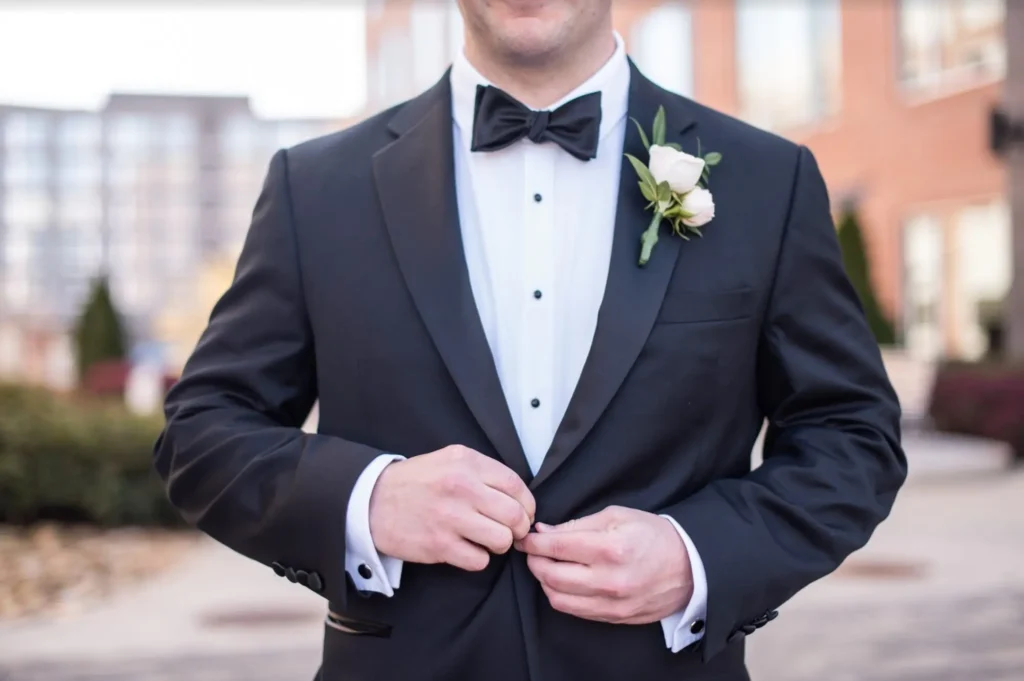
How to Wear a Tuxedo, Piece by Piece
Wearing a tuxedo is all about precision and polish. Every piece plays a role in creating that classic black tie look. Let’s break down the tuxedo ensemble so you know exactly how to wear a tuxedo the right way, from jacket to shoes.
1. The Tuxedo Jacket
The jacket is the centerpiece of your tux. Key features to look for:
- Lapels: Choose between shawl, peak, or notch lapels. Shawl and peak lapels are the most traditional for tuxedos, both typically faced in satin.
- Color: Black and midnight blue are classic choices. For less traditional settings, deep burgundy or ivory jackets can offer a stylish twist.
- Fit: A tailored fit is essential. The shoulders should lie flat, the waist should taper slightly, and the sleeve should show about a quarter inch of your shirt cuff.
Pro tip: Avoid vents (slits) in the back of the jacket for a more formal appearance.
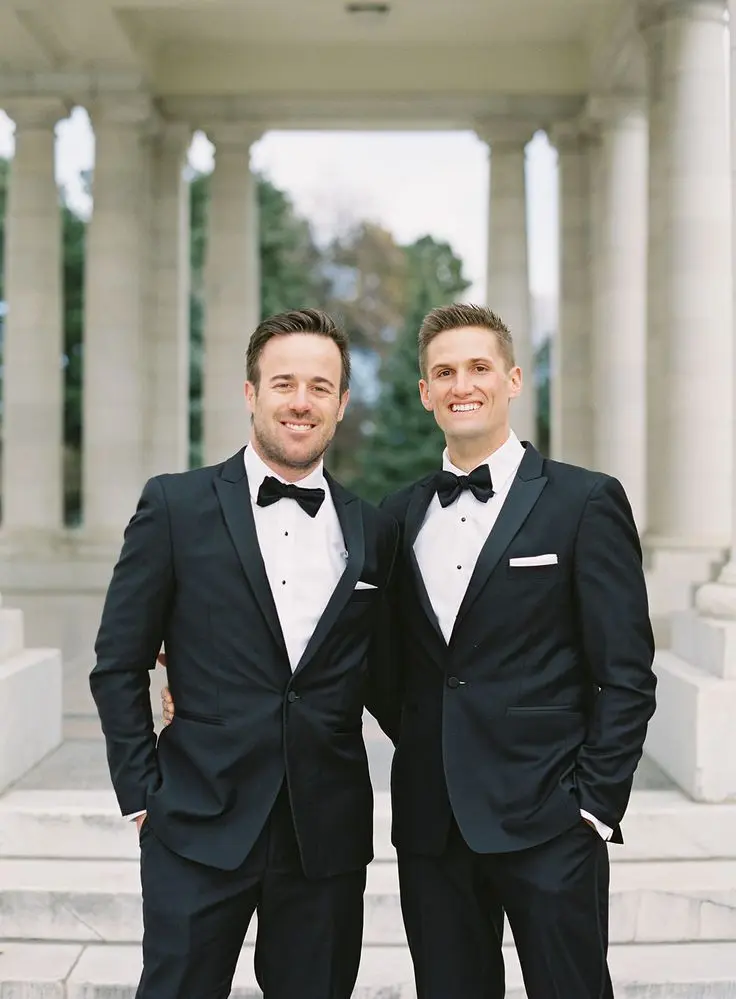
2. The Trousers
Tuxedo trousers are clean and minimal. Look for:
- A satin stripe down the outer leg to match the jacket lapels.
- A high-waisted cut designed to be worn with braces or side adjusters, not belts.
- A clean hem without cuffs, which maintains a more formal silhouette.
3. The Dress Shirt
Your shirt should elevate the formality of the outfit, not clash with it. Here’s what to look for:
- Front style: Pleated, pique bib, or plain front.
- Collar: Wingtip or spread collar, depending on preference and formality.
- Cuffs: French cuffs, worn with cufflinks.
- Fastening: Tuxedo shirts often use studs instead of regular buttons, adding a refined touch.
4. The Bow Tie
The bow tie is the defining neckwear of the tuxedo.
- Color: Black is standard for black tie events.
- Material: Choose satin or grosgrain silk to match the lapel facing.
- Style: Always go for a self-tie bow tie if possible; it adds an authentic, slightly imperfect charm.
- Can you wear a tie with a tux? Technically, no, not for traditional black tie events. A long necktie looks too casual. The bow tie is part of what makes a tuxedo a tuxedo.
5. Footwear
Shoes should be sleek, formal, and polished.
- Patent leather oxfords are the most traditional.
- Opera pumps or plain toe shoes are also acceptable.
- Avoid brogues or anything with visible stitching.
Socks should be black, long enough to cover your calf, and preferably silk or fine cotton for a dressy finish.
6. Accessories
These finishing touches bring the whole tuxedo look together:
- Cummerbund or waistcoat: Choose one, not both. They help cover the waistband and create a smooth transition between jacket and trousers.
- Pocket square: A white pocket square folded neatly adds a polished accent.
- Studs and cufflinks: Choose elegant, understated designs; black onyx or mother-of-pearl are classic.
- Suspenders (braces): A must if your trousers don’t have side adjusters. Never wear a belt with a tux.
Knowing how to wear tuxedo pieces correctly ensures you honor the black tie tradition with style.
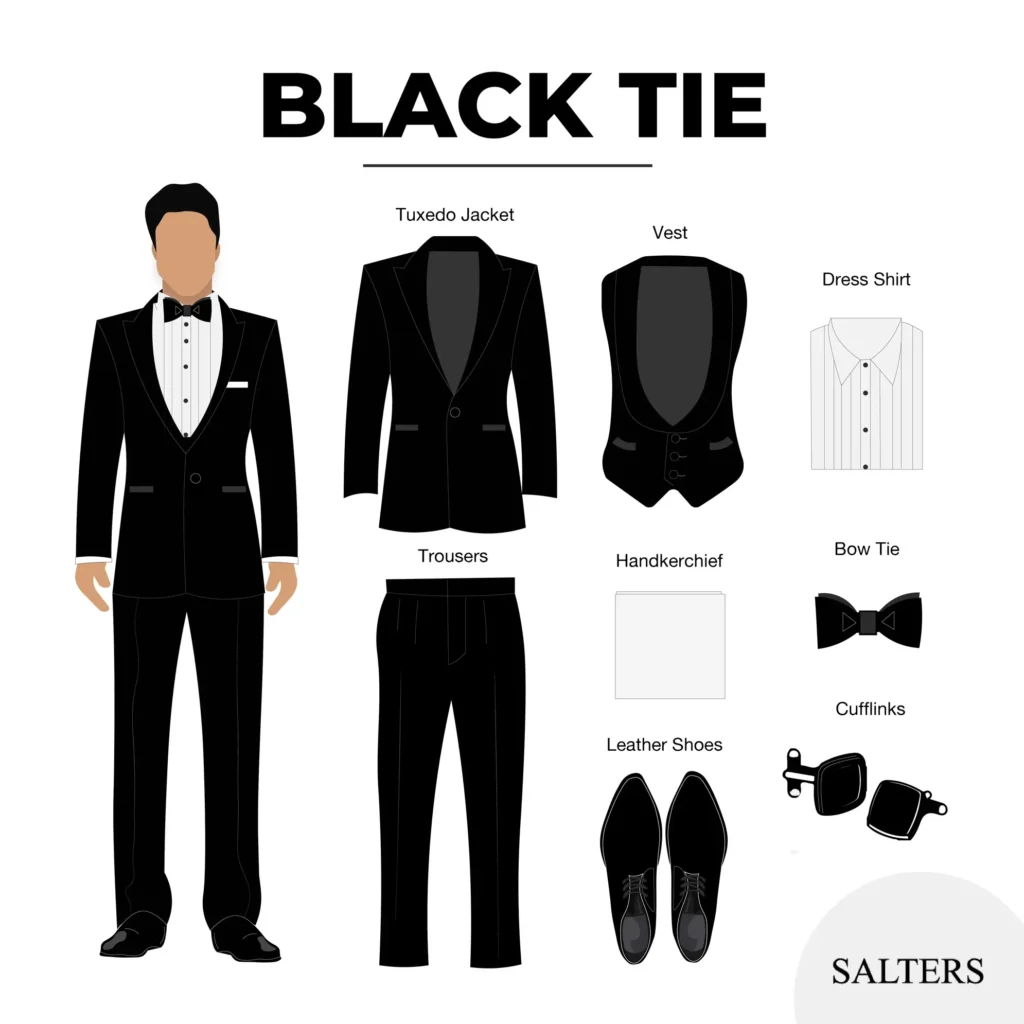
Tuxedo Fit & Grooming Tips
Even the finest tuxedo can fall flat if it doesn’t fit well or if grooming is overlooked. Knowing how to wear a tuxedo isn’t just about assembling the right pieces; it’s also about wearing them with precision, posture, and polish. This section will help you fine-tune the details that elevate your overall appearance.
1. Get the Fit Right, Every Time
Fit is king when it comes to formalwear. A poorly fitted tux can make even a designer ensemble look awkward, while a tailored fit can make a basic tux look exceptional.
Here’s what to check:
- Shoulders: The jacket should hug your shoulders without any pulling or overhang.
- Jacket length: It should cover your seat and fall mid-palm when your arms are at your sides.
- Sleeves: About ¼ to ½ inch of your shirt cuff should be visible.
- Trousers: Should sit high on your waist (above the hips) and fall with a slight break at the shoe.
Tip: Consider investing in tailoring. Off-the-rack tuxedos almost always require adjustments for a polished look.
2. Maintain Clean Lines
Tuxedos are designed to look sharp and structured. Avoid bulky pockets, belt buckles, or oversized accessories that interrupt the clean silhouette. Your shirt should be pressed, your bow tie symmetrical, and your cummerbund (if worn) smooth and facing the right direction (pleats face up).
3. Groom Like a Gentleman
Your grooming should complement the sophistication of your attire.
- Facial Hair: Keep it neat, trimmed, and intentional. If clean-shaven, ensure a smooth, fresh look.
- Hair: Opt for a classic cut or a clean, well-styled appearance that doesn’t distract from your tux.
- Nails: Keep them clean and trimmed, small detail, big impact.
4. Fragrance: Subtle, Not Overpowering
A refined scent can leave a lasting impression, just don’t overdo it. Choose a classic, well-balanced cologne and apply sparingly on pulse points. You want to be remembered, not announced from across the room.
5. Confidence Is Part of the Look
Wearing a tuxedo well goes beyond the fabric. It’s how you carry yourself, shoulders back, eye contact steady, smile ready. The right fit and the right grooming elevate your presence, but confidence is the final touch.
If you truly want to master how to wear a tux or how to style a tuxedo for any event, the details matter. And few details are more noticeable than poor grooming or a bad fit. Respect the garment by presenting your best self in it.
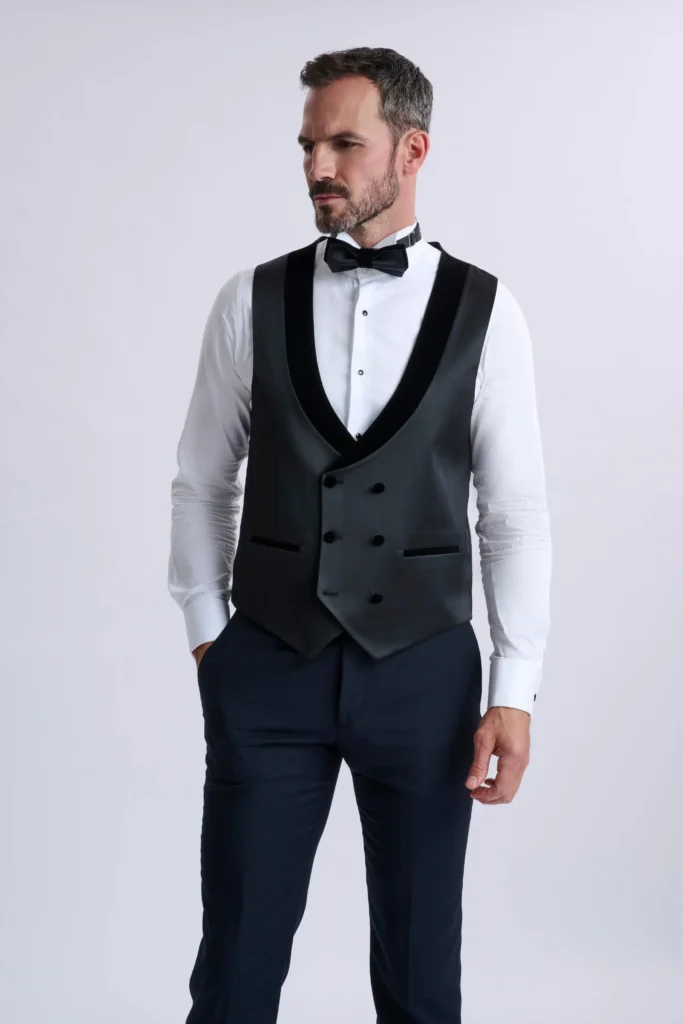
Common Tuxedo Mistakes to Avoid
Wearing a tuxedo should feel effortless, but only when you’ve avoided the subtle (and not-so-subtle) mistakes that can sabotage your look. You already know how to wear a tuxedo properly; now it’s time to ensure you’re not undermining your appearance by missing the mark on the basics.
Here are some of the most common tuxedo mistakes, and how to avoid them:
1. Wearing a Tie Instead of a Bow Tie
One of the most frequent errors in black tie dressing is swapping a bow tie for a long necktie. While the question “Can you wear a tie with a tux?” gets asked often, the answer for traditional black tie events is a firm no. A necktie instantly makes the ensemble look less formal, even mismatched. Stick with a classic black bow tie, and make it self-tied if possible for that authentic finish.
2. Belt with Tuxedo Trousers
Tuxedo trousers are made without belt loops for a reason: they’re not meant to be worn with a belt. Instead, opt for side adjusters or suspenders (braces). Wearing a belt disrupts the clean lines and breaks the flow between the shirt, cummerbund or waistcoat, and trousers.
3. Poorly Fitted Tuxedo
A tuxedo that’s too baggy, too tight, or poorly proportioned will always look off, no matter how expensive it is. A bad fit can make you appear slouched or sloppy. Tailoring is non-negotiable if you want to look sharp and polished.
4. Over-accessorizing
Less is more when it comes to formalwear. Avoid loud patterns, flashy cufflinks, or novelty bow ties at black tie events. Stick to minimal, tasteful accessories that complement your look rather than distract from it.
5. Casual Footwear
Your sneakers, brogues, or loafers may be stylish, but they have no place in black tie dressing. Wearing anything other than sleek, polished patent leather shoes, formal oxfords, or opera pumps brings the entire outfit down a notch.
6. Mismatched Pieces
Mixing elements from a suit and a tuxedo, such as pairing a tuxedo jacket with suit trousers, creates visual confusion. The beauty of a tuxedo lies in its cohesion. Stick to the full ensemble or don’t wear a tux at all.
7. Forgetting to Groom
Even a perfectly styled tux loses its charm if paired with messy hair, unkempt facial hair, or dirty shoes. Grooming is part of the tuxedo package, not an afterthought.
Avoiding these missteps ensures you respect the occasion and the elegance of the tuxedo. After all, wearing a tuxedo is more than just checking boxes; it’s about presenting your most refined self, from head to toe.
Conclusion
Wearing a tuxedo is more than getting dressed; it’s making a statement. It tells the world you understand elegance, tradition, and the power of presentation. From understanding the components of a proper tuxedo to knowing how to wear a tux confidently, you now have the complete blueprint for looking your absolute best at any formal event.
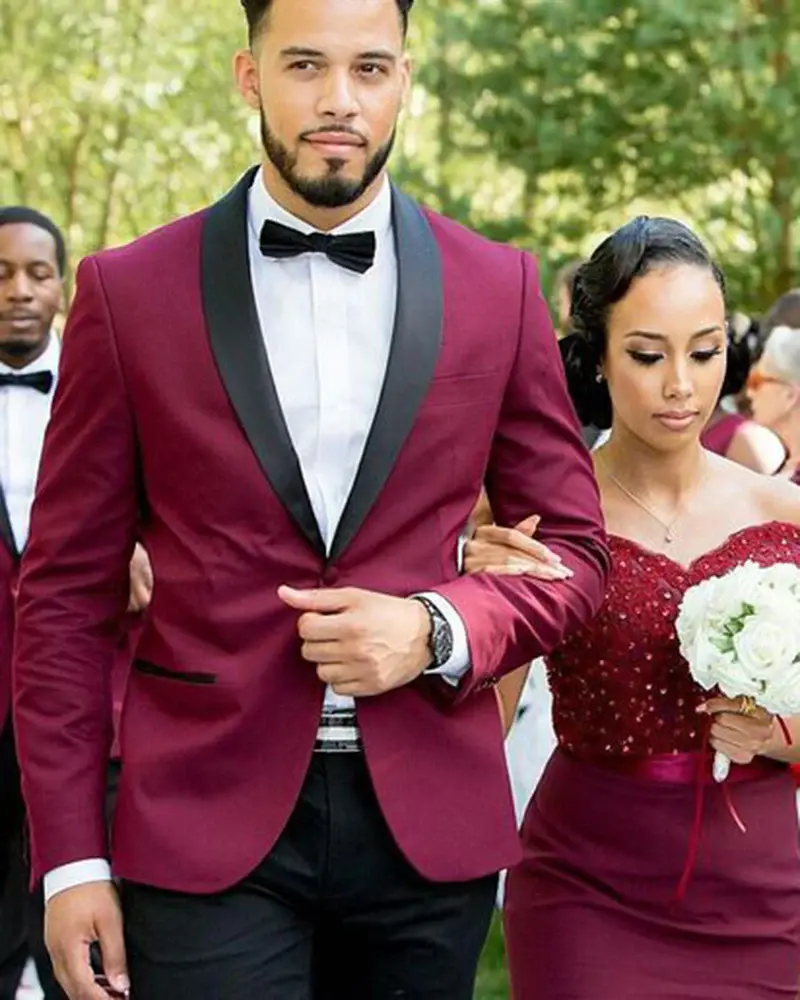
This tuxedo guide has shown you:
- What defines a true black tie tuxedo
- When it’s appropriate to wear one
- How to style a tuxedo piece by piece
- Ways to modernize your look without losing its formality
- The importance of fit, grooming, and confidence
- And the common mistakes to avoid
Remember: when you wear a tuxedo right, you don’t just look the part. You own the room.

